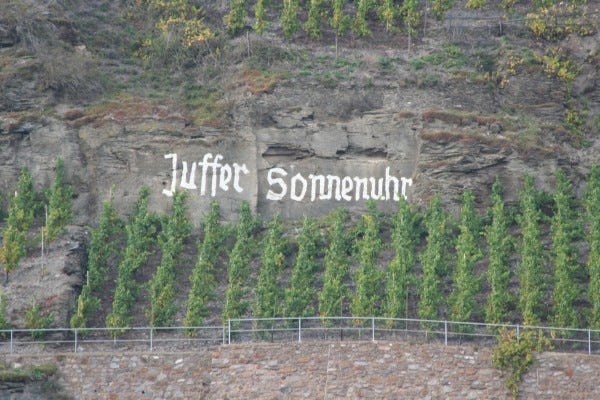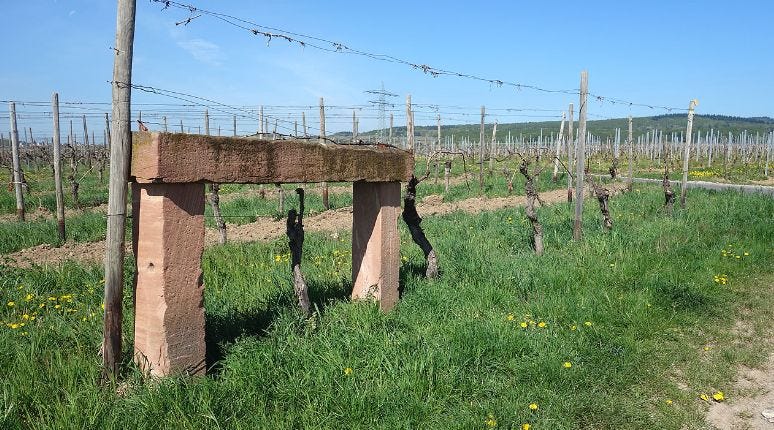I thoroughly enjoyed myself at this event (or as much it is possible when you’re spitting out, rather than drinking, wine) hosted by the importer specialising in Germany, Burgundy and northern Italy.
It wasn’t as crowded as the Keeling Andrew tasting I wrote about in my last post, partly because the venue was larger (it took place in Burlington House in Piccadilly), and partly because the entrance fee was £20 – a bargain when you consider it consisted of 34 top-notch producers from a range of regions, with more than 100 wines to get through.
I had envisaged covering the entire tasting in one post, but I got a bit carried away describing the rieslings, so spatburgunder (pinot noir), silvaner and lemberger (blaufrankisch) will be covered in my next newsletter.
Kabinetts
I was mostly focusing on dry styles, but the kabinett category of wine is worth mentioning. The wines, which are made almost entirely from riesling, can be excellent but tend to be overlooked by many because most of them range from off-dry to medium-sweet with low alcohol levels of around eight per cent. If a huge, oaked and buttery Californian chardonnay is at one end of the white wine scale, a light, delicate kabinett is on the other.
German wine law can be excruciatingly complicated, so I’ll endeavour to be as concise as possible when describing kabinett wines. The grapes must come from 40 select wine producing districts in Germany known as Bereich, which guarantees a level of quality.
Kabinett wines have the lowest must weight levels on the German Pradikatswein scale that includes six categories, which means they are less sweet and luscious than auslese and beerenauslese wines – two more Pradikatswein categories. They are lighter and contain green and citrus fruit, especially younger styles.
The low alcohol levels are ideal for those watching their weekly unit intake but this doesn’t mean they’re not intense. The sweetness complements spicy food such as Thai curry and the high acidity prevents the wine from being too flabby. I urge you to check them out.
I tried a lot of 2023s, which are young and still have fresh green and citrus notes, such as Fritz Haag’s Brauneberger Juffer Kabinett (£17.50) from the Mosel Valley, which is medium-dry (so the sweetness is evident but not too much) and received a score of 18/20 on jancisrobinson.com.
Schloss Lieser’s 2023 Niederberg Helden Kabinett (£17.50) is flinty with a mineral finish. Anne Krebiehl MW mentioned a ‘clementine finish’ in her review. If you have more cash to splash about then check out Joh.Jos. Prum’s 2023 Wehlener Sonnenuhr Kabinett (£34), although this needs time.
Dry riesling
The dry rieslings from the Mosel Valley tend to have more green and citrus fruit than than the Rheingau, at least when young.
Fritz Haag was showcasing the 2023 Juffer GG (£38). ‘GG’ here stands for Grosses Gewachs – the equivalent of a Grand Cru vineyard. ‘Juffer’ is the name of the vineyard and is located in Brauneberg in the Mosel. I found the wine floral, with a herbaceous character (maybe stinging nettle?), quite fruit forward.
I preferred Haag’s 2023 Brauneberger Juffer Sonnenuhr (£38), which is more mineral and herbal than the Juffer – overall more intriguing. Juffer Sonnenuhr is one of the top vineyards in Brauneberger. It's steep (80 per cent gradient) and pure south-facing, to aid ripeness. The soil is fine slate.
Schloss Lieser’s 2023 Goldtropfchen GG (£29) is flinty with very high acidity, which will aid ageing. Goldtropfchen is a vineyard in Piesport on dark Devonian slate, whereas Lieser’s 2023 Niederberg Helden GG (£29) is made from grapes grown on blue slate from some of Lieser’s oldest vines. It had a distinctive lime streak, with green apple and a bit vegetal. Will be drinking from 2027 according to Howard Ripley’s website.
Peter-Jakob Kuhn is a biodynamic producer from Rheingau. I was curious to try the 2020 Sankt Nikolaus GG (£48) as I loved the 2019 vintage when tasting it a few months ago. There were some traces of petrol and stone fruit but it was still quite taut – great tension. May be even better in a couple of years. The Sankt Nikolaus vineyard is just 150 metres from the Rhine river, which exerts a warming influence. The soils are loess and gravel.
Kuhn's 2022 Hendelberg 1G (£37) was quite shy on the nose. White peach comes through on the palate – it was quite juicy. Drink from next year according to Howard Ripley. Hendelberg is a vineyard on slate soil.
I haven’t tasted much riesling from Rheinhessen so didn’t know what to expect. Wagner-Stempel’s 2022 Riesling is great value for just £14. Characterful and juicy. The producer’s 2022 Heerkretz Riesling GG (£44) is made from grapes grown on volcanic soil (in this case rhyolite) – a great selling point these days. It was quite citrusy and needs time. The Heerkretz vineyard is one of the highest in Rheinhessen.
Wittmann has gained a good reputation and is based in southern Rheinhessen. The producer practises biodynamics. The 2023 Kirchspiel GG (£58) is from east-facing sites, so receives lots of sun in the morning. It’s flinty and needs time to develop. The Kirchspiel vineyard is on clay marl with limestone deposits.
Flight 47
I want to drink more whites by Portuguese producer Dirk Niepoort, having tasted a couple of his recently and really enjoyed them. The Conciso 2021 was reduced to £23 in a Wine Society sale and it’s great value at that price (there might be a few more left). From the Dao, it’s made from bical with a bit of encruzado and malvasia. It’s discreetly toasty with wet stone, a citrusy backbone with some white peach. Rather saline finish gives it uniqueness. Just 11.5% abv.
Niepoort’s Triangle Wines Sanha Branco 2021 (£18 Wine Society) is from Bairrada and a blend of maria gomes, bical and cercial. Like the Conciso it’s crisp and linear with some savouriness. Low intervention in the winery, an explanation why there is a hint of funkiness to it. Twenty months’ ageing in 2,500-litre old wooden vats. 12% abv.
I should also mention a fantastic dry furmint I tasted at a recent gathering. The Oremus Petracs Single Vineyard Furmint 2017 is a step up from the Oremus Mandolus I tried at the recent furmint tasting. Extremely expressive orange peel, stone fruit, toast and vanilla with some dried fruit also coming through on the palate. Ripe, high acidity. Not cheap at around £75. A special occasion wine.






